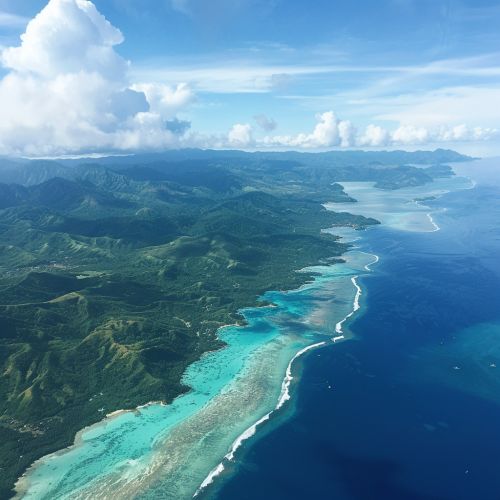Philippines
Geography
The Philippines is an archipelagic country located in Southeast Asia, situated in the western Pacific Ocean. It consists of about 7,641 islandsIsland, which are categorized broadly under three main geographical divisions from north to south: Luzon, Visayas, and Mindanao. The country is bounded by the South China Sea on the west, the Pacific Ocean on the east, and the Celebes Sea on the southwest, and shares maritime borders with Taiwan to the north, Vietnam to the west, Palau to the east, and Malaysia and Indonesia to the south.


History
The history of the Philippines is believed to have begun with the arrival of the first humans using rafts or boats at least 709,000 years ago as suggested by the discovery of Pleistocene stone tools and butchered animal remains associated with hominin activity. The Philippines became a part of the Spanish Empire for more than 300 years. This resulted in Catholicism becoming the dominant religion. During this time, Manila became the western hub of the trans-Pacific trade. In 1898, following the Spanish–American War, the United States acquired the Philippines, which led to a period of American colonial rule. The period of American colonialism had a significant impact on Philippine culture. The United States left a lasting imprint, shaping the political structure, education system, and economy of the Philippines. The Philippines gained independence from the United States on July 4, 1946.
Politics and Government
The Philippines is a democratic republic with a presidential system. The President of the Philippines is both the head of state and the head of government, and serves as the commander-in-chief of the country's armed forces. The president is elected by popular vote and has a term of six years. The current constitution was enacted in 1987, during the presidency of Corazon Aquino. The government of the Philippines is structured as a bicameral system with a House of Representatives and a Senate. The judiciary is independent of the executive and the legislative branches.
Economy
The economy of the Philippines is the world's 31st largest economy by nominal GDP according to the International Monetary Fund 2020 and the 13th largest economy in Asia. The Philippines is one of the emerging markets and is currently transitioning from being based on agriculture to one based more on services and manufacturing. The Philippines is rich in natural resources; however, these assets are not fully utilized due to factors such as corruption, lack of infrastructure, and the country's difficult terrain. The economy is heavily reliant on remittances which surpass foreign direct investment as a source of foreign currency.
Culture
The culture of the Philippines is a combination of cultures of the East and West. Filipino identity was created primarily as a result of pre-colonial cultures, colonial influences and foreign traders intermixing and gradually evolving together. In pre-colonial times, the Philippines was a divided set of nations, islands and tribes being ruled by their own kings, chieftains, lakans, rajahs, datus and sultans. Every nation has its own identity and some are even part of a larger empire outside of what is now the Philippines.
